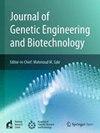Transcriptome Derived Artificial neural networks predict PRRC2A as a potent biomarker for epilepsy
IF 2.8
Q3 Biochemistry, Genetics and Molecular Biology
Journal of Genetic Engineering and Biotechnology
Pub Date : 2025-05-12
DOI:10.1016/j.jgeb.2025.100503
引用次数: 0
Abstract
Epilepsy refers to the occurrence of two or more than two reiterative seizures. The occurrence of seizure is governed by the excessive electrical discharges in the cortex of the brain. Bioinformatics is crucial in diagnosing, prognosticating, and treating neurological disorders. It uses methodologies, computational tools, software, and databases to probe disease molecular underpinnings and identify biomarkers. It aids clinicians in addressing patient parameters and translational research. Artificial neural networks (ANNs) are computer models that attempt to mimic the neurons present in the human brain. This computerized neuronal model is used for analyzing and comprehending large and complex data sets. In the present study, three GEO datasets (GSE190451, GSE140393, and GSE134697) were retrieved from NCBI for the identification of differentially expressed genes using the DESeq2 package. The study identified 7 up-regulated genes (PRRC2A, FCGR3B, HLA-DRB, ENSG00000280614, ENSG00000281181, SLN, C4A) in patients with epilepsy. Furthermore, WEKA software was used for feature selection and classification of DEGs using feature selection algorithms namely Correlation Feature Selection, ReliefF, and Information Gain and classification methods such as Logistic regression, Classification via regression, Random forest, Random subspace, and Logistic model trees. After the analysis, out of the 7 genes, the C4A gene was removed as it yielded the lowest feature selection statistics. Lastly, R Studio was used for constructing the Artificial Neural Network of the 6 identified DEGs. The model’s performance was evaluated using the “pROC” R package, and an AUC of 0.720 was obtained, indicating that the model had excellent classification accuracy. The NeuralNet package of R revealed that PRRC2A had the highest generalized weight value indicating the increased expression of these genes when all other parameters are constant. Therefore, PRRC2A can be used as a potential biomarker for the diagnosis of epilepsy.
转录组衍生的人工神经网络预测PRRC2A是癫痫的有效生物标志物
癫痫是指发生两次或两次以上反复发作。癫痫发作的发生是由大脑皮层的过度放电控制的。生物信息学在诊断、预测和治疗神经系统疾病方面至关重要。它使用方法学、计算工具、软件和数据库来探测疾病的分子基础和识别生物标志物。它帮助临床医生解决患者参数和转化研究。人工神经网络(ANNs)是试图模仿人类大脑中存在的神经元的计算机模型。这种计算机化的神经元模型用于分析和理解大型复杂的数据集。本研究从NCBI中检索三个GEO数据集(GSE190451、GSE140393和GSE134697),使用DESeq2包鉴定差异表达基因。本研究在癫痫患者中发现了7个上调基因(PRRC2A、FCGR3B、HLA-DRB、ENSG00000280614、ENSG00000281181、SLN、C4A)。利用WEKA软件对deg进行特征选择和分类,采用相关特征选择、ReliefF、Information Gain等特征选择算法和Logistic回归、classification via regression、Random forest、Random subspace、Logistic模型树等分类方法。经过分析,在7个基因中,C4A基因因其产生的特征选择统计量最低而被删除。最后,利用R Studio构建6个已识别的deg的人工神经网络。使用“pROC”R包对模型的性能进行评价,得到的AUC为0.720,表明该模型具有较好的分类精度。R的NeuralNet包显示,PRRC2A具有最高的广义权重值,表明当所有其他参数不变时,这些基因的表达增加。因此,PRRC2A可以作为癫痫诊断的潜在生物标志物。
本文章由计算机程序翻译,如有差异,请以英文原文为准。
求助全文
约1分钟内获得全文
求助全文
来源期刊

Journal of Genetic Engineering and Biotechnology
Biochemistry, Genetics and Molecular Biology-Biotechnology
CiteScore
5.70
自引率
5.70%
发文量
159
审稿时长
16 weeks
期刊介绍:
Journal of genetic engineering and biotechnology is devoted to rapid publication of full-length research papers that leads to significant contribution in advancing knowledge in genetic engineering and biotechnology and provide novel perspectives in this research area. JGEB includes all major themes related to genetic engineering and recombinant DNA. The area of interest of JGEB includes but not restricted to: •Plant genetics •Animal genetics •Bacterial enzymes •Agricultural Biotechnology, •Biochemistry, •Biophysics, •Bioinformatics, •Environmental Biotechnology, •Industrial Biotechnology, •Microbial biotechnology, •Medical Biotechnology, •Bioenergy, Biosafety, •Biosecurity, •Bioethics, •GMOS, •Genomic, •Proteomic JGEB accepts
 求助内容:
求助内容: 应助结果提醒方式:
应助结果提醒方式:


